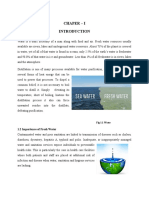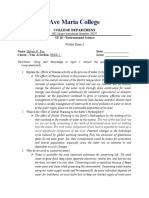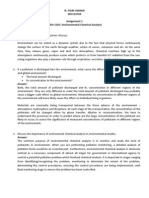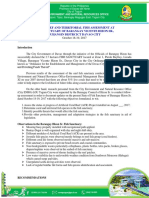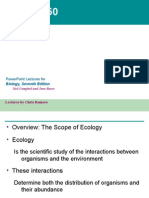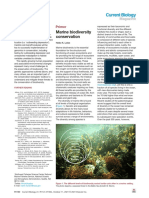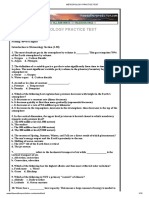0 ratings0% found this document useful (0 votes)
63 viewsWeek 3 Progress Check
Week 3 Progress Check
Uploaded by
Joshua Ray Calago1. Engineering activities that utilize freshwater can negatively impact freshwater systems by overexploiting resources without sufficient conservation efforts.
2. Changes in the primary productivity of aquatic systems, such as decreased plant life, can diminish water and food supplies since many populations rely on aquatic resources.
3. Ocean currents are biologically significant as they transport plankton and influence animal migration patterns important for breeding and feeding.
Copyright:
© All Rights Reserved
Available Formats
Download as DOCX, PDF, TXT or read online from Scribd
Week 3 Progress Check
Week 3 Progress Check
Uploaded by
Joshua Ray Calago0 ratings0% found this document useful (0 votes)
63 views2 pages1. Engineering activities that utilize freshwater can negatively impact freshwater systems by overexploiting resources without sufficient conservation efforts.
2. Changes in the primary productivity of aquatic systems, such as decreased plant life, can diminish water and food supplies since many populations rely on aquatic resources.
3. Ocean currents are biologically significant as they transport plankton and influence animal migration patterns important for breeding and feeding.
Original Title
..
Copyright
© © All Rights Reserved
Available Formats
DOCX, PDF, TXT or read online from Scribd
Share this document
Did you find this document useful?
Is this content inappropriate?
1. Engineering activities that utilize freshwater can negatively impact freshwater systems by overexploiting resources without sufficient conservation efforts.
2. Changes in the primary productivity of aquatic systems, such as decreased plant life, can diminish water and food supplies since many populations rely on aquatic resources.
3. Ocean currents are biologically significant as they transport plankton and influence animal migration patterns important for breeding and feeding.
Copyright:
© All Rights Reserved
Available Formats
Download as DOCX, PDF, TXT or read online from Scribd
Download as docx, pdf, or txt
0 ratings0% found this document useful (0 votes)
63 views2 pagesWeek 3 Progress Check
Week 3 Progress Check
Uploaded by
Joshua Ray Calago1. Engineering activities that utilize freshwater can negatively impact freshwater systems by overexploiting resources without sufficient conservation efforts.
2. Changes in the primary productivity of aquatic systems, such as decreased plant life, can diminish water and food supplies since many populations rely on aquatic resources.
3. Ocean currents are biologically significant as they transport plankton and influence animal migration patterns important for breeding and feeding.
Copyright:
© All Rights Reserved
Available Formats
Download as DOCX, PDF, TXT or read online from Scribd
Download as docx, pdf, or txt
You are on page 1of 2
Week 3 Progress Check
1. In what ways do engineering processes and activities impinge on the functioning
freshwater systems”
Engineering activities that utilize freshwater is most likely the answer, humans
have been using freshwater as drinking water and for daily necessities, many people
have come up with ideas to exploit freshwater resources but hasn’t spared a thought
on how to conserve the source of the freshwater which is the catch basins the nature
has made.
2. How can changes in primary productivity of aquatic systems affect the use of aquatic
resources?
The primary productivity of aquatic systems directly affects the output of the
source, this diminishes our water supply and also food resources since aquatic
resources aren’t totally water which means there are a lot in our aquatic resources to
take into account and it totally affects our use on aquatic resources since majority of
the population that live near aquatic resources rely on those resources for food and
income as a living.
3. Explain the significance of ocean current to marine systems.
Ocean currents bring life, first thing is it brings plankton for ecosystems to feed
on and it also brings the warm currents that usually is followed by migrating aquatic
animals for their breeding and feeding seasons.
4. Describe the properties of seawater that are of biological significance.
Seawater is very rich in oxygen, has its salinity and it has nutrients; making it
perfect for sustaining life since it has enough nutrients and other factors to sustain the
development of organisms.
5. Outline the physical and chemical characteristics of a waterbody that make them
susceptible to pollution.
Waterbodies are made up of a lot of water, water is known as the universal
solvent which has the tendency to mix with other substances which makes it
susceptible to pollution and other harmful factors like red tide.
6. Why can the deposition of small quantities of some pollutants give rise to large-scale
disruption of ecological systems?
Aquatic ecosystems have small lifeforms, which is crucial for the food supply of
most of the members of that ecosystem, that is why a small deposition hits hard on
ecological systems since it would cause an imbalance on the food supply, affecting the
overall circulation of energy in the food chain.
7. Compare and contrast the causes and effects of acidification with cultural
eutrophication of freshwater ecosystems
Both Eutrophication and Acidification are similar different cases, eutrophication
is most likely to occur on freshwater areas that are affected by human activities that
dump chemicals, leading to an imbalance of nutrients and eventual growth of algaes
whilst acidification occurs due to concentrations of carbon dioxide in the ocean, greatly
lowering the PH level of the seawaters.
8. What procedures are generally used for cleaning up oil spills? Which are the most
biologically friendly?
Oil spills in the sea are quite troublesome since they can cause devastating
effects to the surroundings and most probably the ecosystem within the area, I’ll be
explaining 2 ways to clean up oil spills on which is better and which is not; first method
is In-situ Burning, this method burns the vast majority of the oil from the top making it
very effective, quick, and cost-efficient but the downsides to this is that it heavily
contributes to the greenhouse effect; the other method is known as bioremediation
where bacteria, algae or fungi is used to break down the oil spill, which eventually
would clear out all the remaining oil in the area, this is a safe method but time
consuming, costly and less efficient compared to the other one but is it worth it? My
answer is no, a huge price to pay is a huge difference rather than taking a toll to our
own planet which would eventually lead to our own destruction and extinction.
9. What are the ecological consequences of sewage input to the marine environment?
Sewage inputs has always done worse than good because in the long run it
would eventually saturate our environment with unnecessary chemicals and nutrients,
eventually it would pollute the land and our groundwater resources and would reach
our primary water sources in time.
10. Explain the physical chemical phenomenon of using a water tower absorb ammonia into
water from an ammonia pollution air source.
Water would be able to catch molecules suspended in the air with this method
and eventually clean out the ammonia clouded air and come out mixed with water.
You might also like
- Environmental Studies: Field Work OnDocument21 pagesEnvironmental Studies: Field Work OnKolkata Foodie89% (36)
- Sean Burke - MR T Hydrothermal Vents WebquestDocument3 pagesSean Burke - MR T Hydrothermal Vents Webquestapi-386190429100% (1)
- APES Notes - Chapter 17: Water Pollution and Its PreventionDocument11 pagesAPES Notes - Chapter 17: Water Pollution and Its Preventionirregularflowers100% (1)
- Introduction of Pond Ecosystem111Document31 pagesIntroduction of Pond Ecosystem111Shiva Kumar100% (2)
- Water PollutionDocument9 pagesWater PollutionDAYA RAM SAHNo ratings yet
- Aquatic BiomesDocument5 pagesAquatic BiomesMusab AlbarbariNo ratings yet
- dp1 ESS revision sheetDocument6 pagesdp1 ESS revision sheetGamez MastersNo ratings yet
- Water Pollution ControlFrom EverandWater Pollution ControlSuresh T. NesaratnamNo ratings yet
- Chapter 1Document31 pagesChapter 1Mohd Azman SuwandiNo ratings yet
- Water Chemistry PDFDocument11 pagesWater Chemistry PDFLeandro MichelsenNo ratings yet
- EARTH SCIENCE Q1 WK 5.a Human Activities On Water For Student 1Document14 pagesEARTH SCIENCE Q1 WK 5.a Human Activities On Water For Student 1KING OF GAMER 2.0No ratings yet
- EutrophicationDocument5 pagesEutrophicationNarelle IaumaNo ratings yet
- ULO3 BDocument3 pagesULO3 BKaris DemetriaNo ratings yet
- CPalms Tutorial Aquatic Ecosystems Rev 2Document3 pagesCPalms Tutorial Aquatic Ecosystems Rev 2jkfdjfjfdgNo ratings yet
- Boyd 1998 WQ Air TawarDocument10 pagesBoyd 1998 WQ Air Tawarbungawmutiara69No ratings yet
- Aquatic Ecosystem Report FinalDocument12 pagesAquatic Ecosystem Report FinalRICHARD MUSAUNo ratings yet
- Water Quality and Water Quality Management in AquacultureDocument20 pagesWater Quality and Water Quality Management in AquacultureAhmed Rashid100% (1)
- Water PollutionDocument21 pagesWater PollutionyekarlNo ratings yet
- Table of ContentDocument21 pagesTable of ContentJamieNo ratings yet
- Management Aquatic PlantsDocument19 pagesManagement Aquatic PlantsroverankingNo ratings yet
- Lab 8 - Nutrient Pollution (1)Document8 pagesLab 8 - Nutrient Pollution (1)asemkhattab2005No ratings yet
- Green Modern Nature PresentationDocument12 pagesGreen Modern Nature PresentationRicky jhonsNo ratings yet
- Saint Mary'S University School of Engineering, Architecture and Information TechnologyDocument3 pagesSaint Mary'S University School of Engineering, Architecture and Information TechnologyJeje CruzNo ratings yet
- Ross - Aquaculture and PhytoplanktonDocument10 pagesRoss - Aquaculture and Phytoplanktonjr3807No ratings yet
- Huma GeographyDocument4 pagesHuma Geographyminasadia2004No ratings yet
- TE434 Week 3 Ecological System Disturbances and Pollutions Water Pollution - Quality 2Document26 pagesTE434 Week 3 Ecological System Disturbances and Pollutions Water Pollution - Quality 2Althea Luz BalgameNo ratings yet
- Seatwork Chapter 5 - Impact To WaterDocument3 pagesSeatwork Chapter 5 - Impact To WaterChristopher Ege100% (1)
- Activity 4-BORREDocument4 pagesActivity 4-BORRELara Mae Felizardo BorreNo ratings yet
- Evriomental Engineering PDFDocument9 pagesEvriomental Engineering PDFlyta sinagaNo ratings yet
- Darsh Kumar TulsyanDocument14 pagesDarsh Kumar Tulsyanronakkedia218No ratings yet
- Afa Water Management 449Document4 pagesAfa Water Management 449Ronald A. CarniceNo ratings yet
- Chapter One Water Supply EngineeringDocument8 pagesChapter One Water Supply Engineeringحميد مجيدNo ratings yet
- Semester9 OE GE Notes ChatGPTDocument59 pagesSemester9 OE GE Notes ChatGPTbsuhail126No ratings yet
- Pgdem 03Document169 pagesPgdem 03monikaNo ratings yet
- Phase Interactions in Aquatic ChemistryDocument33 pagesPhase Interactions in Aquatic ChemistryPeter John Paul Tariman100% (1)
- Lesson No. 1 NotesDocument8 pagesLesson No. 1 NotesMayette Rose SarrozaNo ratings yet
- Pollution of Ground WaterDocument6 pagesPollution of Ground Waterzen142No ratings yet
- Aquaponics System, Plants. Volume 1: Sistemas de acuaponíaFrom EverandAquaponics System, Plants. Volume 1: Sistemas de acuaponíaNo ratings yet
- Apes U8 Aquatic and Terrestrial PollutionDocument4 pagesApes U8 Aquatic and Terrestrial Pollutionapi-352694884No ratings yet
- ES036A K3 - C2 AssignmentDocument7 pagesES036A K3 - C2 AssignmentKyle QuindaoNo ratings yet
- Project Report On The Effect of Thermal Pollution and Oil Spill On Marine AnimalsDocument25 pagesProject Report On The Effect of Thermal Pollution and Oil Spill On Marine Animalsgopal kiradooNo ratings yet
- CHAPTER-1 FinalisedDocument19 pagesCHAPTER-1 FinalisedShyam SundarNo ratings yet
- Aquaponics system, fish. Volume 1: Sistemas de acuaponíaFrom EverandAquaponics system, fish. Volume 1: Sistemas de acuaponíaNo ratings yet
- Marine Enviroment 2 (Autosaved)Document67 pagesMarine Enviroment 2 (Autosaved)AlexNo ratings yet
- Sea Water Converted Into Usable and Emergency Drinkable WaterDocument7 pagesSea Water Converted Into Usable and Emergency Drinkable WaterIJRASETPublicationsNo ratings yet
- Social(2)1Document3 pagesSocial(2)1ajaysudevan31No ratings yet
- Water Pollution ForumDocument4 pagesWater Pollution ForumRyanNo ratings yet
- Biology Grade 10 (Weeks 1-5) - Term 3Document86 pagesBiology Grade 10 (Weeks 1-5) - Term 3Daniel DowdingNo ratings yet
- Water 2Document2 pagesWater 2Michael VillamorNo ratings yet
- Environmental Science3Document5 pagesEnvironmental Science3Mylene Namang EsicNo ratings yet
- Water Pollution in Maasin CityDocument14 pagesWater Pollution in Maasin Cityjessabelmantilla7No ratings yet
- Biological Productivity NotesDocument2 pagesBiological Productivity Notesavi97No ratings yet
- Kami Export - Ishan Gole - HumanEffectonResourcesDocument6 pagesKami Export - Ishan Gole - HumanEffectonResourcesIshan GoleNo ratings yet
- Chapter 3 HydrosphereDocument17 pagesChapter 3 HydrosphereHarshpreet SinghNo ratings yet
- N. Fajri Usman SEH110704 Assignment 1 SHEH 2105: Environmental Chemical AnalysisDocument5 pagesN. Fajri Usman SEH110704 Assignment 1 SHEH 2105: Environmental Chemical AnalysisFajri UsmanNo ratings yet
- at What Condition Any Activity For The Environment Is Valued As Utilitarian Justification?Document5 pagesat What Condition Any Activity For The Environment Is Valued As Utilitarian Justification?zilani ahmedNo ratings yet
- Describe A Specific Ecosystem Type of FreshwaterDocument7 pagesDescribe A Specific Ecosystem Type of FreshwaterCharle TsaiNo ratings yet
- CBSE Class 10 Science Chapter 13: Our Environment - 2 Mark Questions With AnswersDocument2 pagesCBSE Class 10 Science Chapter 13: Our Environment - 2 Mark Questions With AnswersSACHIN ClassNo ratings yet
- Chap 1Document36 pagesChap 1kaltsegaye866No ratings yet
- Layson - R GE 15 ULOc Let's Analyze PDFDocument2 pagesLayson - R GE 15 ULOc Let's Analyze PDFAyah LaysonNo ratings yet
- Water Pollution and Its Control: Case StudyDocument13 pagesWater Pollution and Its Control: Case StudySE HariharasudhanNo ratings yet
- Geo and Get Full Mark (3rd)Document144 pagesGeo and Get Full Mark (3rd)冰川No ratings yet
- EchinodermsDocument35 pagesEchinodermsVillamorchardNo ratings yet
- Prospectus2010 11Document68 pagesProspectus2010 11Mir Dost100% (1)
- Vadhavan DPR - May 2023 - Compressed-1Document222 pagesVadhavan DPR - May 2023 - Compressed-1M Singh0% (1)
- Assignment I-Climate Change - DocDocument1 pageAssignment I-Climate Change - DocRahulTiwariNo ratings yet
- BMKG-Weather Forecast-PHE ONWJ WEST 09012023 - 0452Document7 pagesBMKG-Weather Forecast-PHE ONWJ WEST 09012023 - 0452johan andrianNo ratings yet
- Sound in the Sea Lab—Stirring Up SoundDocument2 pagesSound in the Sea Lab—Stirring Up Soundkari08collinsNo ratings yet
- Fish Sanctuary Assessment - Davao CityDocument3 pagesFish Sanctuary Assessment - Davao CityLuigie BagoNo ratings yet
- Powerpoint Lectures For: Biology, Seventh EditionDocument69 pagesPowerpoint Lectures For: Biology, Seventh Editionxo_simpledream100% (1)
- Geofile Coral ReefsDocument4 pagesGeofile Coral ReefsBecky GrayNo ratings yet
- The National Territory of The PhilippinesDocument39 pagesThe National Territory of The Philippinesraenee_041096% (79)
- Evidence of A Changing Climate: Rising TemperaturesDocument6 pagesEvidence of A Changing Climate: Rising TemperaturesyabbppiNo ratings yet
- Es 200 - Assignment 1: Prof. Virendra SethiDocument9 pagesEs 200 - Assignment 1: Prof. Virendra SethiSanchay SaxenaNo ratings yet
- Climate Velocity Reveals Increasing Exposure of Deep-Ocean Biodiversity To Future WarmingDocument17 pagesClimate Velocity Reveals Increasing Exposure of Deep-Ocean Biodiversity To Future WarmingRaquel MarianiNo ratings yet
- Fishing in India MasemariDocument5 pagesFishing in India MasemariRahul JadhavNo ratings yet
- Marine Biodiversity Conservation: PrimerDocument6 pagesMarine Biodiversity Conservation: PrimerGIANELLA VALERI QUISPE CONTRERASNo ratings yet
- Q4 2018 AnswersDocument5 pagesQ4 2018 Answersdd4f2ybpgzNo ratings yet
- # Name Address AtollDocument60 pages# Name Address AtollmdponlineNo ratings yet
- DRAFT TNSLURB SLR Project Interim Final Report March 14 2017Document61 pagesDRAFT TNSLURB SLR Project Interim Final Report March 14 2017vasanth paramanandhanNo ratings yet
- Meteorology Practice TestDocument10 pagesMeteorology Practice TestouruleNo ratings yet
- Explanation Text (2, 6, 16, 25, 30) Xi.6Document13 pagesExplanation Text (2, 6, 16, 25, 30) Xi.6Aliyya Dhiya AmruNo ratings yet
- Coral LeefDocument2 pagesCoral LeefDeepraj VermaNo ratings yet
- General CirculationDocument63 pagesGeneral CirculationAdam Yustin AmanullahNo ratings yet
- AIWFBDocument13 pagesAIWFBgarrychahal0060No ratings yet
- Hazardous Environments 9.3 Hazards From Atmospheric DisturbancesDocument58 pagesHazardous Environments 9.3 Hazards From Atmospheric DisturbancesCastanasRebeccaNo ratings yet
- Reading ComprehensionDocument16 pagesReading ComprehensionjoanabalonNo ratings yet
- Mangrove Field GuideDocument1 pageMangrove Field GuideHaröld BuènvenidaNo ratings yet
- Crossword yO6EyqJBlKDocument2 pagesCrossword yO6EyqJBlKJhumannNevikNo ratings yet
- How To Mark No Go AreasDocument3 pagesHow To Mark No Go AreasGerald Handerson100% (2)









































